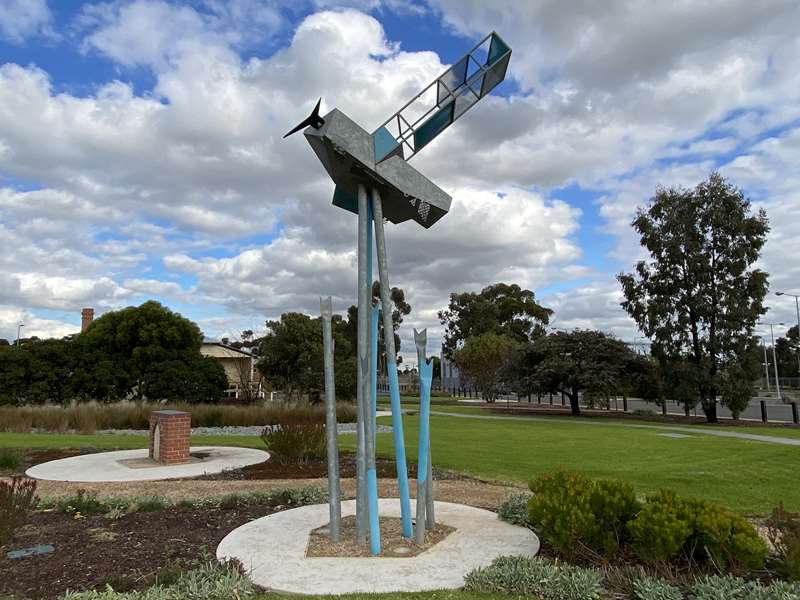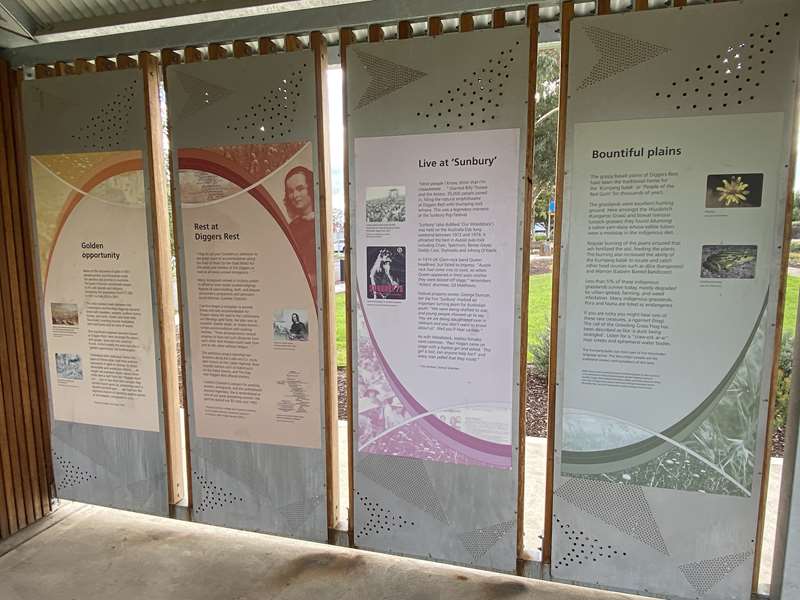Houdini's Flight Memorial (Diggers Rest)


The memorial in Stan Payne Reserve at Diggers Rest celebrates the centenary of first powered controlled sustained circuit flight in Australia 21/03/1910 - 21/03/2010.
It acknowledges famous escapologist Harry Houdini as the first person to make a successful, controlled, powered circuit flight in Australia at "Plumpton Paddock", Diggers Rest in a Voisin biplane on 21 March 1910. The flight duration was 7mins 37secs and the height achieved was 100ft.
In the reserve there is a shelter with two tables, BBQ, toilets and water tap.

On the sides of the shelter are the following local stories:
Golden Opportunity
News of the discovery of gold in 1851 spread quickly and thousands made the perilous sea journey to Australia. The quiet Victorian countryside began to fill with people and industry, increasing the population from 77,000 in 1851 to 546,000 in 1861.
The once isolated roads between the Castlemaine and Bendigo diggings became lined with travellers, wagons, bullock teams, horses, and tents. Hotels and food stalls flourished, rooming houses multiplied, and merchants sold all sorts of wares.
One significant stopover became known as Diggers Rest. Here amongst the plains and gorges, food and rest could be found. Unfortunately the area was also a 'golden opportunity' for bushrangers:
"Individual after individual within the space of three miles had their pockets ransacked of gold or money, by these detestable and audacious villains ... At length we overtook them, about three miles and a half from the "Diggers Rest" Inn ... but in less than five minutes they turned round upon us, presenting each a double barrelled gun, ... we had not the slightest chance of standing against pieces so formidable, compared to ours, "
- Thomas Gregory, The Argus, 1852.
Rest at Diggers Rest
"I beg to call your Excellency's attention to the great want of accommodation along the lines of Road (to the Gold fields) for the wives and families of the Diggers as well as all newly arrived Immigrants ..."
Many immigrants arrived in Victoria unable to afford or even locate suitable lodgings. Reports of overcrowding, theft, and disease concerned a sympathetic and persistent social reformer, Caroline Chisholm. Caroline began a campaign to provide cheap and safe accommodation for Diggers along the road to the Castlemaine and Bendigo gold fields. Her plan was to establish 'shelter sheds' or 'shake-downs'; simple accommodation with cooking facilities: "These encampments I would propose to have (at) such distances from each other that females could walk from one to the other without fatigue ..."
The ambitious project identified ten locations along the Cobb and Co. route, later known as the Calder Highway. Busy wayside stations such as Robertson's on the Keilor Downs, and The Gap near Diggers Rest offered shelters.
Caroline Chisholm's concern for working women, immigrants, and the unemployed became legendary. She is remembered as one of our great pioneering women. Her portrait graced our $5 note until 1992.
* Extracts are from a letter from Caroline Chisholm to Sir Charles Flotham, Lieutenant Governor of Victoria, 1854 Public Records Office.
Live at 'Sunbury'
"Most people 1 know, think that I'm craaazeeeee ..." chanted Billy Thorpe and the Aztecs. 35,000 people joined in, filling the natural amphitheatre at Diggers Rest with thumping rock refrains. This was a legendary moment at the Sunbury Pop Festival.
'Sunbury' (also dubbed 'Our Woodstock') was held on the Australia Day long weekend between 1972 and 1974. It attracted the best in Aussie pub-rock including Chain, Spectrum, Renee Geyer, Daddy Cool, Skyhooks and Johnny O'Keefe.
In 1974 UK Glam-rock band Queen headlined, but failed to impress. "Aussie rock had come into its own, so when Queen appeared in their satin clothes they were booed off stage," remembers 'Aztecs' drummer, Gil Matthews.
Festival property owner, George Duncan, felt the first 'Sunbury' marked an important turning point for Australian youth: "We were being drafted to war, and young people showed up to say, 'hey we are being slaughtered over in Vietnam and you don't want to know about us'. Well you'll hear us now"
As with Woodstock, topless females were common. "Paul Hogan came on stage with a topless girl and asked, 'This girl is lost, can anyone help her?' and every man yelled that they could."
- Tim Lambert, festival attendee
Bountiful Plains
The grassy basalt plains of Diggers Rest have been the traditional home for the 'Kurnjang balak' or 'People of the Red Gum' for thousands of years.
The grasslands were excellent hunting ground. Here amongst the Wuuloitch (Kangaroo Grass) and bowat (various tussock-grasses) they found Murnong a native yam-daisy whose edible tubers were a mainstay in the indigenous diet.
Regular burning of the plains ensured that ash fertilized the soil, feeding the plants. The burning also increased the ability of the Kurnjang balak to locate and catch other food sources such as djira (kangaroos) and Warron (Eastern Barred Bandicoot).
Less than 5% of these indigenous grasslands survive today, mostly degraded by urban spread, farming, and weed infestation. Many indigenous grasslands, flora and fauna are listed as endangered.
If you are lucky you might hear one of these rare creatures, a ngarrert (frog). The call of the Growling Grass Frog has been described as like 'a duck being strangled'. Listen for a "craw-ork ar-ar" near creeks and ephemeral water bodies.
The Kurnjang balak clan form part of the Wurundjeri language group. The Wurundjeri people are the traditional owners and custodians of this land.
Location
78 Old Calder Highway, Diggers Rest 3427 View Map









